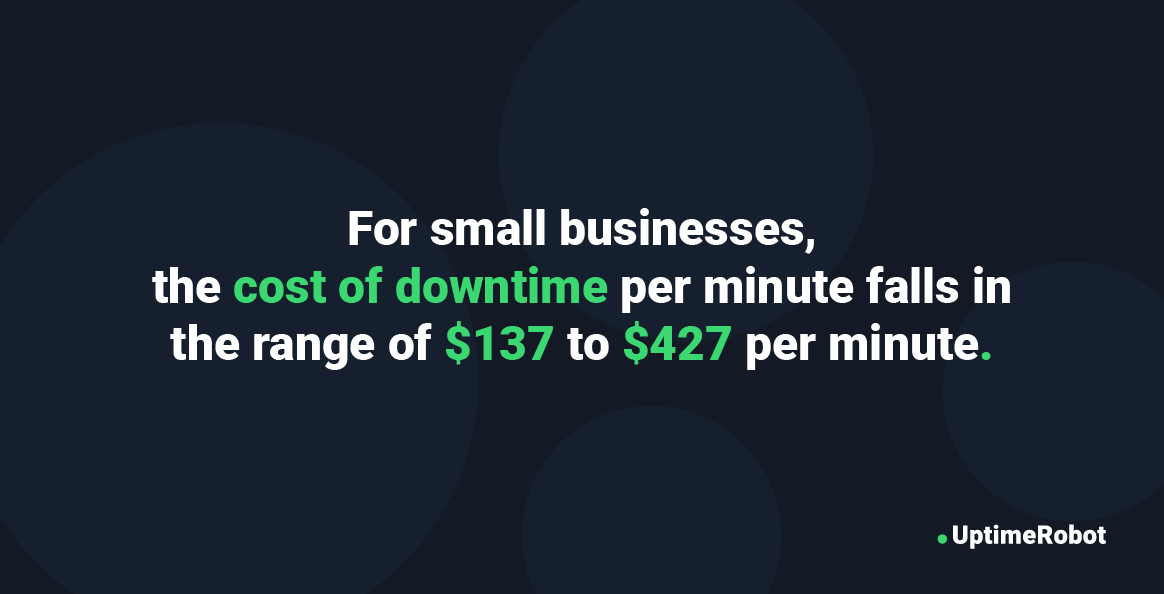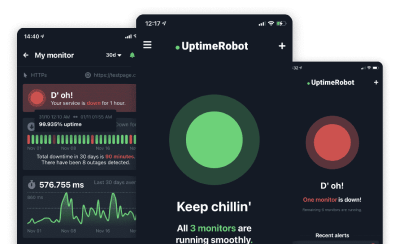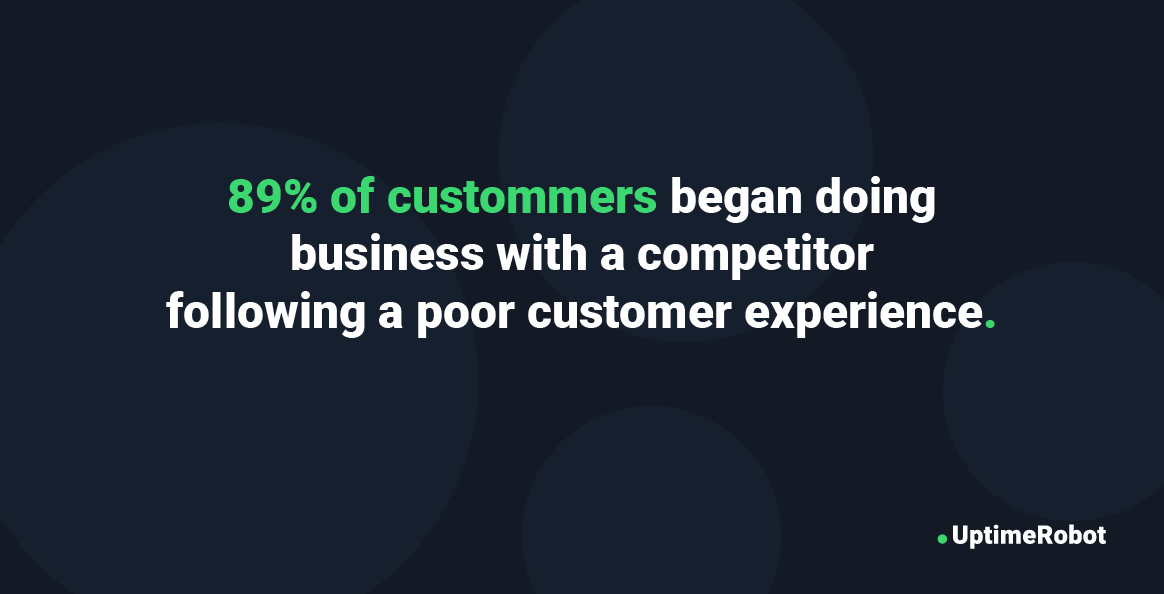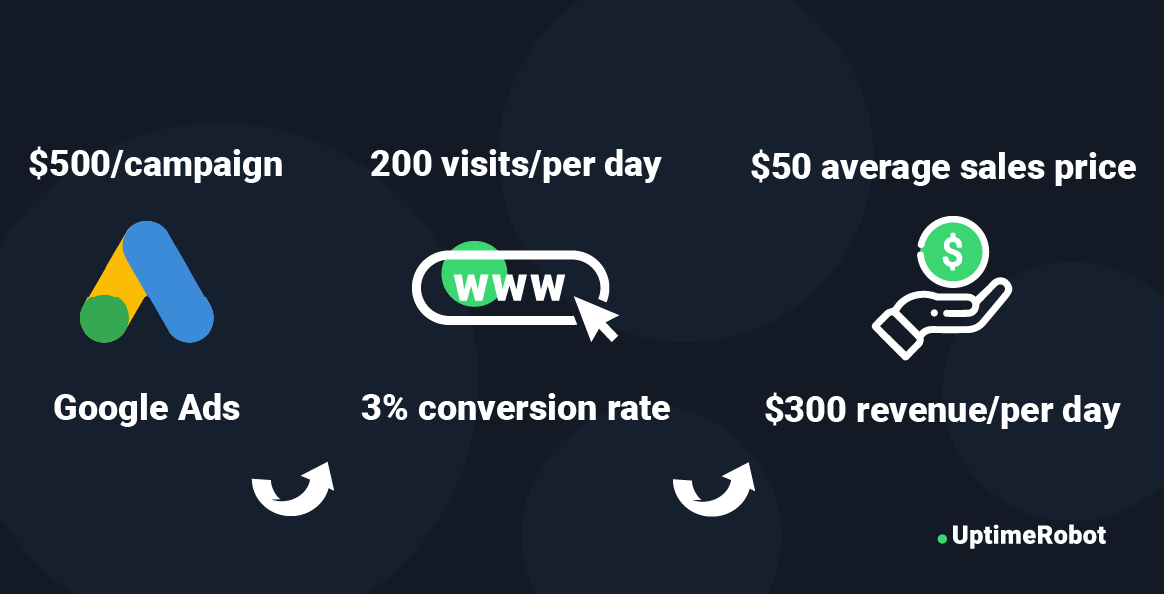Quick links
You likely already know how important it is to have a reliable website for your business — After all, your website is often the first point of contact between your company and potential customers.
And if that website is not accessible or functioning properly, you could be missing out on some key opportunities to grow.
Addressing website downtime, monitoring your site regularly, and establishing a strong plan for handling potential issues are all essential to maintaining a positive online presence for your business.
Defining and Understanding Downtime
Website downtime (or outage) is a period during which a site is completely or partially inaccessible to users due to certain technical issues.
Websites can be down for many reasons, including server issues, technical glitches, or maintenance. The average website is down three hours per month, during which visitors are unable to access the website’s content, features, or services. This can lead to a less-than-ideal experience for customers and potentially cause long-term consequences for a brand.
And some of these consequences can be measured in cold, hard cash.
How to Calculate the Cost of Downtime?
Nothing halts momentum quite like your website going offline. But here’s the kicker: the real cost of downtime can be even deeper when you factor in the ripple effects on brand reputation and customer trust.
Understanding the full impact of downtime isn’t just about crunching numbers. It requires a comprehensive approach that takes into consideration both the immediate losses and the more subtle, long-term implications.
Here’s a step-by-step breakdown to help you calculate it:
Direct Costs
These are the immediate costs that can be tied directly to the downtime event. A simple way to calculate this is through this formula:
(Average Hourly Revenue / 60) x Minutes of Downtime
For example, if a business makes $120,000 a day, its hourly revenue is $5,000. For 10 minutes of downtime, the direct cost would be roughly $833.
Indirect Costs
These are more subtle and can be harder to measure, but they play a significant role in the overall cost of a downtime event:
- Loss of Employee Productivity: During downtime, employees may be inactive, leading to lost man-hours. This can be measured by calculating the combined hourly wages of impacted employees.
- Increased Customer Support Costs: A surge in customer complaints or inquiries can lead to overtime payments and additional resources to manage customer relations.
- Reputation Damage: Although hard to monetize, a damaged reputation can lead to a decline in customer trust and reduced business over time. Some companies calculate this by looking at negative reviews, canceled subscriptions, or analyzing potential lost business from negative word-of-mouth.
- Penalties or Refunds: For businesses bound by Service Level Agreements (SLAs) or those that promise uptime guarantees, downtime can mean paying penalties to clients or providing refunds.
- Remediation Costs: This involves the costs associated with rectifying the cause of the downtime, whether that’s repairing hardware, hiring external consultants, or purchasing new software.
- Lost Opportunities: During periods of downtime, businesses can miss out on new sales, partnership opportunities, or other potential revenue streams. This could involve missed advertising revenue or lost transaction opportunities.
Total Cost of Downtime: Direct Costs + Indirect Costs
Using the previous example, if the direct cost for 10 minutes is $833, and the added indirect costs, such as customer support overtime ($200), lost productivity ($300), and remediation costs ($150), amount to $650, the total would be $1,483 for just 10 minutes of downtime.
While the direct impact of downtime is clear, the ripple effect of hidden and prolonged costs can continue to affect a business long after operations resume.
The Most Common Causes of Downtime
With businesses relying heavily on online platforms for operations and customer interaction, understanding why a website might go down is crucial. Even small issues can cause a site to crash, and the effects can be big — affecting both current earnings and the company’s reputation. By spotting and addressing these issues early on, businesses can cut down on the chances and consequences of unplanned outages.
Here are some common causes of downtime and the impact they carry:
- Server Overloads: High traffic or sudden surges can exceed a server’s capacity, causing it to crash. For example, ticket-selling sites often crash when high-demand events go on sale.
- Cyberattacks: According to a report from Cybercrime Magazine, global cybercrime costs are expected to reach $10.5 trillion annually by 2025, up from $3 trillion USD in 2015. DDoS attacks, malware, and ransomware can all cause significant downtimes.
- Hardware Failures: Even with advancements in technology, hardware components can still fail. According to a study by Biz Journals, hardware failures –especially failures due to hardware that needs to be replaced or repaired– are one of the top three causes of unplanned downtimes.
- Software Glitches: Inadequately tested software updates or conflicts between different software can lead to unexpected downtimes.
- Human Error: Accidental changes or deletions by staff, especially in the IT department, can result in downtimes. A study from CompTIA, the IT industry association, shows that “human error accounts for 52 percent of the root causes of security breaches,” many of which can lead to website downtime.
- Natural Disasters: Events like earthquakes, floods, or fires can disrupt physical infrastructure, leading to downtime.
💡TIP: If you found this breakdown insightful and are looking to delve deeper into the ripple effects and often overlooked repercussions of downtime, be sure to check out our article 6 Common Reasons for Website Downtime (and how to fix it) for a comprehensive overview.
Cost of Downtime per Industry
Every industry faces unique challenges and relies on technology to varying extents. This means that when a website or system goes down, the money loss can be different for each industry — and it’s essential to understand these differences to get a full picture of the potential impacts of downtime. While the actual costs can vary based on several factors, here are some averages to give you a ballpark figure.
Retail
E-commerce giants like Amazon can lose millions during outages. For the broader retail industry, a significant portion of sales now comes from online platforms, and the average cost of downtime can be estimated at around $10,000 per minute.
When Amazon suffered a 59-minute outage in 2021, the company missed out on $34m in sales.
Finance and Banking
For an industry that relies heavily on real-time transactions and online services, downtime can be particularly expensive. The average cost for this industry has been estimated at approximately $12,000 per minute, but some experts believe the number is much higher, with up to “$9.3 million U.S. dollars per hour in the banking/finance industry.”
In 2018, Visa experienced a system failure that caused over 5 million transactions to fail to process properly. While exact loss figures weren’t disclosed, we can assume the losses were monumental.
Healthcare
Hospitals and health systems depend on electronic health records and various online tools for patient care. A downtime can lead to delayed services or even critical mishaps.
Because most of the revenue streams in today’s hospitals are directly linked to digital systems, NetTech Consultants estimates that “unplanned downtimes cause many health facilities an average of $208,600 in immediate lost revenue.”
This doesn’t include additional costs in end-user productivity losses (which could be as high as $138,200), reputation damage, and fines. According to NetTech Consultants, “Fines that arise from compromising patient’s privacy can be as high as $50,000 for each occurrence.”
Telecommunications and Online Services
Considering the vast infrastructure and numerous servers most telecom giants operate, these numbers can quickly accumulate. In 2020, Google’s 45-minute outage is estimated to have cost the company “as much as $47 million conservatively ($350,000 per minute).”
Manufacturing
With many processes now digitized, any disruption can halt production lines, resulting in significant losses. The manufacturing sector, on average, faces downtime costs of approximately $8,000 per minute. For giants like General Motors or Siemens, even a minor glitch can result in losses in the millions.
Transportation
Modern transportation and logistics rely heavily on digital tools for tracking, routing, and scheduling. Downtime can result in missed deliveries and service interruptions. In fact, overall vehicle downtime costs fleets $3.3 billion USD each year.
In September 2023, United Airline’s system went down for several hours, resulting in thousands of flight delays and cancellations worldwide. Passengers were unable to check-in online, affecting not just those flying that day but also causing a ripple effect on the airline’s operations for several days. While the final numbers aren’t out yet, the event is likely to have cost the airline millions in compensation, rerouting, and operational setbacks.
So What Exactly Are the Costs of Downtime?
The cost of downtime varies depending on many factors. For example, the bigger the company, the harder it’ll be hit if its website goes down.
When Facebook had a major six-hour outage in October 2021, it cost the company about $164,000 a minute (or roughly $60 million total) in revenue, according to Marketwatch. This also triggered a chain effect that caused Facebook shares to go down by 4.9%, resulting in a massive loss of $47.3 billion in market cap.
The good news is that if you’re one of the little guys, your downtime costs will certainly be less. For small businesses, the cost of downtime per minute falls in the range of $137 to $427 per minute, according to Carbonite.

Website downtime costs also vary widely among industries, as each vertical has its own distinct set of revenue models. Factors like customer expectations, transaction volumes, and reliance on web-based services all contribute to shaping the financial implications of downtime for each industry.
The average cost across industries is $5,600 per minute (a whopping $300,000 per hour). According to Gardner, this happens to be the average in the IT industry too.
If that sounds big, wait to hear how much other companies could be losing on revenues during an outage.
- In the manufacturing industry, the cost of downtime is approximately $260,000 per hour. With so many aspects of manufacturing (including machine maintenance and asset service or support) now depending on computers and the internet to run properly, the cost of downtime can run into millions of dollars.
- In the enterprise industry, the cost of downtime “exceeds $1 million to over $5 million, exclusive of any legal fees, fines or penalties,” according to TechChannel. Even for small businesses with fewer than 50 employees, the cost can still easily reach $100,000 per hour.
- In the telecommunications industry, downtime can cost an estimated $11,000 per minute, per server, according to Franklin Electric. This could easily add up to millions of dollars per year, especially for larger companies with several servers.
A report published by Fusion Connect shows that industries connected to retail, banking and finance, energy, healthcare, and transportation have some of the highest downtime price tags — about $5 Million for a 60-minute outage.
1. Revenue Loss
In March 2019, a 14-hour outage cost Facebook an estimated $90 million. When Facebook went down again in 2021 (this time for only six hours), it cost the company nearly $100 million in revenue.
And when Amazon suffered a 59-minute-long outage in 2021, experts estimate it missed out on about $34 million in sales.
A 2014 study conducted by management consulting company Gartner found that the average cost of downtime is $5,600 per minute. By 2016, Ponemom Institute was estimating the average at nearly $9,000 per minute. The position of your company on this broad range depends on various factors such as the industry you’re in, the size of your organization, and your business model.
2. Reputation Damage
The adage “all publicity is good publicity” doesn’t always hold true, particularly for companies experiencing errors, issues with customer support, or website downtime.
In fact, the negative publicity surrounding poor customer experiences (as a website being down would cause) can severely damage a company’s reputation. Let’s face it — word spreads quickly on social media and review platforms. One unhappy customer can convince many others to stay away from your brand.
A report by Fusion Connect accurately points out that “any business that has customers relying on access for purchases, questions about product availability, support services, or product information is also likely to disappoint their customers” if there’s an outage.
The negative repercussions of website downtime grow with a company. So if you’re Amazon or Facebook, people rely a lot more on you than if you are “unknown Joe” — that’s great for your bank account when things are going well, but very bad when something goes wrong.
The damage to your brand’s reputation can be massive and create a negative perception of the company’s reliability and professionalism.
When BlackBerry suffered a global service outage in 2011, the company was already in trouble — mostly because the rise of the more powerful Apple’s iOS and Google’s Android were quickly making BlackBerry obsolete.
But when the four-day outage happened in October 2011, things took a quick turn for the worse. At the time, the UK newspaper The Guardian published an article titled “Service restored, but BlackBerry may never repair its reputation.” They were right, of course — between 2011 and 2016, the company went from a market share of over 33% (in the UK) in 2011 to just 0.04%, according to Toptal.
In 2015, United Airlines suffered two major outages that grounded its entire fleet for several hours. There was so much negative publicity and customer frustration due to this, that the airline was soon named as one of the most unreliable in the country. The poor reputation not only stuck but actually got worse — in a 2023 report by Reader’s Digest, United Airlines was ranked as “the airline with the worst reputation in America.”
3. Customer Dissatisfaction
In today’s fast-paced world where users expect instant access to information, website downtime can significantly impact customer satisfaction.
A customer experience report by Oracle found that “89% of customers began doing business with a competitor following a poor customer experience.” Breaking up isn’t hard to do either — customers aren’t as loyal as you would think and 86% of them will happily pay somebody else more money if that results in a better customer experience.
Loss of user trust after website downtime also makes it less likely that customers will return to your site in the future.
A study by the Aberdeen Group makes it clear that the downtime doesn’t even have to last that long. A simple “1-second delay in page load time equals 11% fewer page views, a 16% decrease in customer satisfaction, and 7% loss in conversions.”
Website down for just a few minutes? Doesn’t matter, your potential customers are already upset and discouraged from coming back.
Not convinced? A 2020 survey conducted by cloud-based data protection company Infrascale showed that more than a third (37%) of companies surveyed have lost customers after website downtime. If your site is down and a potential customer goes somewhere else, they are also more likely to then continue buying from that company rather than coming back to you.
4. Increased Customer Support Inquiries
During downtime, your customer support team may be inundated with inquiries and complaints, putting additional strain on your resources.
Imagine this scenario: As customers try to access your website to make purchases during a special sale, they encounter error messages or slow-loading pages. Unable to complete their transactions, these frustrated customers may turn to the company’s customer support channels, such as phone lines, email, or social media, to seek assistance or report the issue.
This surge in inquiries can overwhelm the customer support team, leading to longer response times, higher costs, and further dissatisfaction among customers. Plus, support won’t be able to attend to other tasks when overwhelmed by one particular issue.
Customers may even perceive website downtime as a lack of care and attention to customer service. They may wonder if you are aware of the issue or if you are doing anything to fix it.
5. Loss of Revenue From Paid Ads
Paid ads continue to be shown to users even when your website is experiencing downtime. But if users click on the ads they will likely encounter an error page or be unable to access the site — and you will still be charged for all the clicks on the ads, even if they’re going nowhere.
This can result in a waste of advertising budget and a poor user experience, as potential customers cannot access your website to learn more or make a purchase.
Let’s say you invest $500 on a five-day-long Google Ads campaign to drive traffic to your website that sells personalized exercise plans. Now let’s imagine you currently receive around 200 visits from your Google Ads campaign, with a conversion rate of 3% (meaning 6 sales per day). If the average sale price of your exercise plans is $50, this means you’re generating about $300 in revenue per day from a Google Ads campaign.
Now imagine your website’s hosting provider is suddenly down, resulting in your website being inaccessible for a full day. During this time, anyone clicking on your Google Ads will see an error message, unable to make a purchase. That’s $300 in sales you’re now losing.
You now need to add to that the cost of one day lost ($100) in the Google Ads campaign you already paid for. The end result? You’ve now lost $400 without any returns.
6. SEO Impact Because of Lower Search Engine Rankings
Prolonged website downtime can negatively affect a site’s search engine rankings, as search engines like Google use website availability as one of the factors in determining rankings.
This loss is temporary, according to Google’s John Mueller, who explains that you should recover rankings in a week or two after the downtime incident (via Search Engine Journal).
But just because the ranking loss is temporary, it doesn’t mean you won’t lose money. Let’s say the drop moves you from page one of Google search results to page two.
Not a big deal, right? Wrong.
Think about the downtime period and SEO from a broader marketing perspective. According to research by Backlinko, just 0.63% of people click on something from the second page of Google search results.
In addition to that, if your website is unavailable for a longer time, the reputation of your company will also start suffering, resulting in a lower number of organic searches for your branded keywords.
Essentially, whenever a Google user can’t find or visit your website due to a downtime period, they might start searching for alternatives – your competitors.
This could significantly lower the overall share of searches for your brand within your industry on Google, which, at the end of the day, could cost you a lot of money.
Final Thoughts
The cost of downtime – whether related to lost revenue or a damaged reputation – can be substantial and far-reaching. By proactively investing in reliable hosting, regular monitoring, and a robust contingency plan, you can minimize the risks associated with downtime and maintain a strong online presence.


